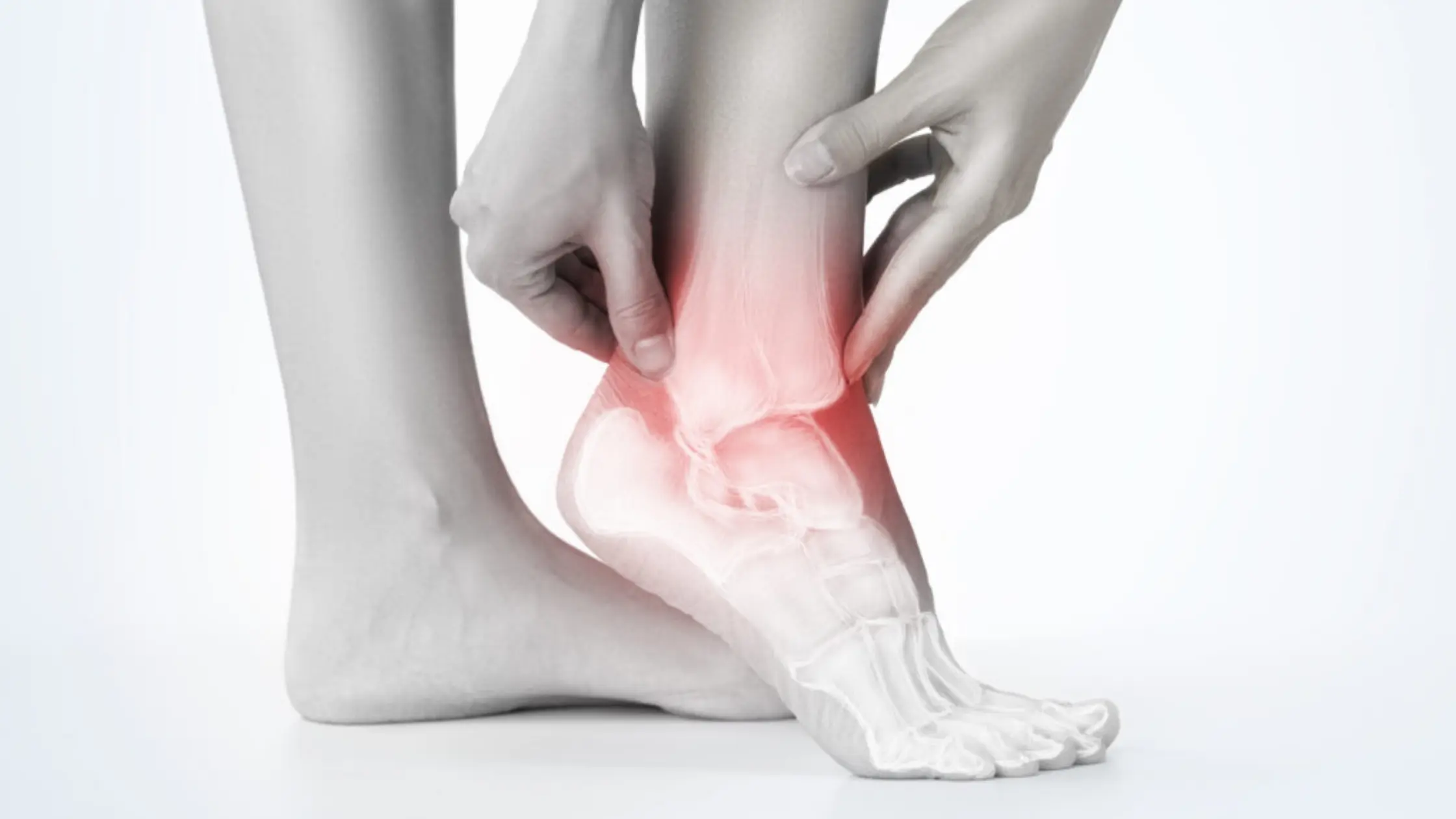The sinus tarsi syndrome is a painful ankle condition that often goes undiagnosed, yet it can significantly impact mobility and quality of life—especially during pregnancy, when weight changes and ligament shifts put extra stress on the feet and ankles.
This guide will explore what sinus tarsi syndrome is, its symptoms, causes, treatment options, exercises, radiology insights, surgical care, and pregnancy-specific considerations.
What is Sinus Tarsi Syndrome?
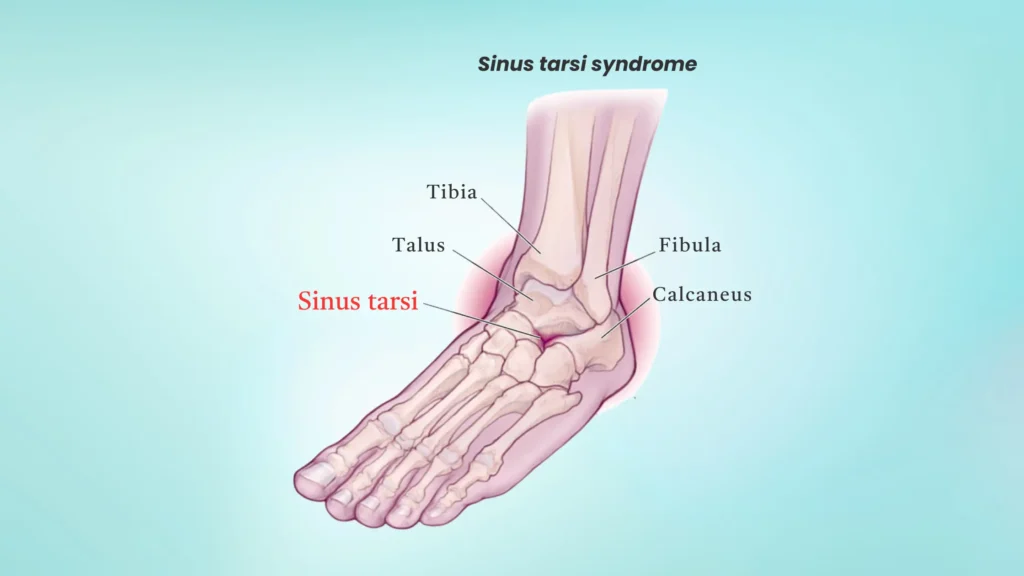
The sinus tarsi syndrome occurs when the small canal on the outside of the ankle, known as the sinus tarsi, becomes inflamed or unstable. With this space, there are ligaments, nerves, and blood vessels that anchor the ankle.
Common causes include:
- Ankle sprains or repetitive twisting injuries: The sinus tarsi area is often injured after ankle sprains. Repeated twisting or rolling of the ankle can damage the supporting ligaments, leading to chronic inflammation and pain.
- Overpronation (rolling the foot inward while walking): When the foot rolls inward excessively, it places extra stress on the sinus tarsi region. Over time, this abnormal movement pattern can irritate soft tissues and cause discomfort.
- Chronic instability of the ankle joint: If the ligaments around the ankle are weak or overstretched, the joint becomes unstable. This instability makes the ankle more prone to small, repeated micro-injuries that inflame the sinus tarsi.
- Structural changes during pregnancy: Hormonal changes, particularly the release of relaxin, loosen ligaments throughout the body. Combined with weight gain and shifting balance, this increases susceptibility to ankle instability and sinus tarsi syndrome during pregnancy.
Sinus Tarsi Syndrome Symptoms
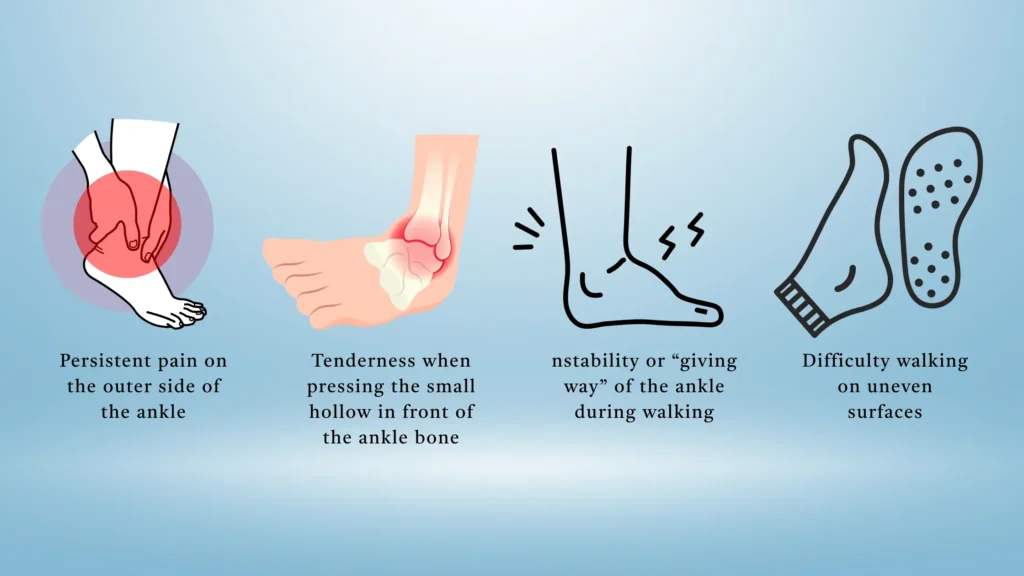
Recognizing sinus tarsi syndrome symptoms early helps prevent worsening pain. Key signs include:
- Persistent pain on the outer side of the ankle: People with sinus tarsi syndrome often feel ongoing discomfort in the small hollow just outside the ankle bone. The pain may worsen with activity, walking, or standing for long periods.
- Tenderness when pressing the small hollow in front of the ankle bone: Direct pressure over the sinus tarsi area typically causes sharp pain, helping clinicians identify the affected region.
- Instability or “giving way” of the ankle during walking: Weak ligaments or inflammation in the sinus tarsi can make the ankle feel unstable, increasing the risk of twists or sprains.
- Difficulty walking on uneven surfaces: Irregular surfaces compound the instability further, influencing difficulty or awkward pain when walking over inclines, stones, or stairways.
- Swelling and stiffness after prolonged standing, especially in pregnancy: Fluid retention and elevated pressure on the ankle may cause leg stiffness when one has been standing on the feet too long, especially in pregnancy.
Sinus Tarsi Syndrome and Pregnancy
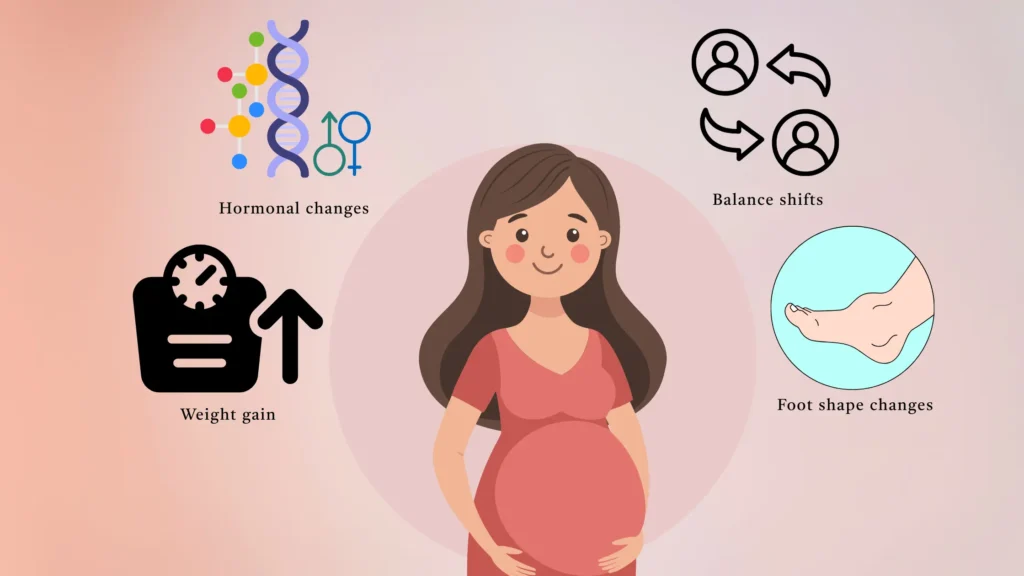
Pregnancy uniquely affects this condition due to:
- Hormonal changes: In order to prepare for childbirth, the hormone relaxin is released during pregnancy. Although this ligament laxity is good for the pelvis, it also affects the ankle, increasing the risk of instability and sinus tarsi syndrome.
- Weight gain: Putting more weight on the feet and ankles puts more strain on the sinus tarsi area. Pain and exhaustion may worsen as a result of this additional stress, especially after extended standing or walking.
- Foot shape changes: Many pregnant women experience flattening of the arches, which increases overpronation and places more strain on the ligaments around the sinus tarsi, contributing to discomfort.
- Balance shifts: As the center of gravity changes during pregnancy, gait and posture are altered. These balance adjustments can exacerbate ankle instability, making walking on uneven surfaces more challenging and increasing the risk of micro-injuries in the sinus tarsi area.
Pregnant women with sinus tarsi syndrome should focus on gentle, safe exercises, supportive footwear, and non-invasive treatments before considering surgery.
Sinus Tarsi Syndrome Radiology
Imaging tests are frequently used to evaluate the internal anatomy of the ankle and rule out other disorders in order to make an accurate diagnosis of sinus tarsi syndrome. Common techniques in radiology include:
- X-rays: These are typically the first step in imaging. X-rays help rule out fractures, arthritis, or bone abnormalities that could mimic sinus tarsi syndrome symptoms. They do not show soft tissue damage, but are useful for excluding structural bone issues.
- MRI scans: Magnetic Resonance Imaging is the most reliable method for detecting soft tissue problems. MRIs can reveal ligament damage, inflammation, scar tissue, or subtle ankle joint injuries. For pregnant women, MRIs without contrast are generally considered safe and provide detailed insight without radiation exposure.
- Ultrasound: This imaging method visualizes soft tissue changes in real time. It can detect ligament swelling and fluid accumulation, and guide targeted injections to reduce inflammation or provide local pain relief. Ultrasound is non-invasive and safe during pregnancy.
Sinus Tarsi Syndrome Treatment Options
Effective management of this condition necessitates a mix of conservative and occasionally surgical measures.
Nonsurgical Treatments for Sinus Tarsi Syndrome

Conservative management of sinus tarsi syndrome is frequently the first line of treatment, particularly during pregnancy. These techniques seek to lessen discomfort, increase stability, and stop additional injuries:
- Rest & ice: Short-term rest from activities that aggravate the ankle, combined with ice packs, helps reduce inflammation and relieve pain in the sinus tarsi region.
- Anti-inflammatory medication: Pregnancy limits the use of nonsteroidal anti-inflammatory drugs (NSAIDs), despite the fact that they can help reduce pain and swelling. Prior to taking any medication, always get medical advice.
- Orthotics: Custom or over-the-counter insoles can correct overpronation, support arches, and reduce ankle strain, providing significant relief for those with sinus tarsi syndrome.
- Best shoes for sinus tarsi syndrome: Shoes with stability features, firm heel support, and wide, cushioned soles help lessen the strain on the sinus tarsi. Supportive shoes are necessary for everyday comfort because pregnant women may also require additional space to accommodate swelling.
- Physical therapy: Guided exercises focus on strengthening ankle muscles, improving stability, and restoring mobility. Physical therapists can design pregnancy-safe routines to maintain ankle health without risking falls or overexertion.
Surgical Treatment for Sinus Tarsi Syndrome
Sinus tarsi syndrome surgery. If nonsurgical options, such as rest, orthotics, supportive shoes, and physical therapy, fail to relieve symptoms, surgery for sinus tarsi syndrome may be an option. The objectives of surgery are to achieve a stable, pain-free, and functionally adequate ankle. The common practices include:
- Debridement: To lessen pain and increase mobility, inflamed tissue, scar tissue, or adhesions within the sinus tarsi are removed.
- Ligament repair or reconstruction: Tightening or repairing damaged ligaments that contribute to ankle instability.
- Foot alignment correction: In some cases, surgical adjustments may be made to correct structural issues that exacerbate sinus tarsi strain.
Pregnancy considerations
Because of the risks associated with anesthesia and the possible effects on fetal safety, surgery is typically delayed until after pregnancy. During pregnancy, nonsurgical management is preferred, with an emphasis on stability, pain management, and safe exercise until delivery.
After surgery, physical therapy is usually recommended to restore strength, balance, and range of motion, thereby ensuring long-term ankle health.
Sinus Tarsi Syndrome Exercises

Ankle strength, stability, and pain associated with sinus tarsi syndrome can all be eased using mild, specific exercises. Pregnant women should perform these exercises with caution, focusing on their balance and safety:
- Ankle alphabet: While seated, trace the letters of the alphabet in the air with your toes. This exercise increases ankle mobility and flexibility without putting weight on the joint.
- Heel raises: Stand while holding onto a stable surface for support, and slowly raise your heels off the ground. Heel raises strengthen the calf muscles and improve ankle stability, which helps reduce stress on the sinus tarsi.
- Resistance band inversion/eversion: Using a resistance band around the foot, gently move the foot inward (inversion) and outward (eversion). This targets the ankle ligaments, promoting strength and preventing instability.
- Balance training: Exercises on a wobble board or balance pad improve proprioception and stability. For pregnancy, ensure modifications are made—hold onto a chair or wall, and avoid high-risk movements that could cause falls.
Best Shoes for Sinus Tarsi Syndrome

Features of the Best Shoes for Sinus Tarsi Syndrome
Appropriate footwear is important in pain reduction, ankle stability, and minimizing re-injury, particularly during pregnancy, in which the feet support extra body weight. Key features include:
- Cushioned midsoles for shock absorption: Soft, supportive midsoles help cushion impact when you walk or stand so less pressure is placed on the sinus tarsi and its surrounding ligaments.
- Firm heel counters for ankle stability: A solid heel counter helps support and maintain alignment in the heel and, therefore, prevents too much turning or lack of stability in the ankle.
- Wide toe boxes for pregnancy-related swelling: Extra space in the toe area accommodates swelling and prevents compression, which is common during pregnancy.
- Orthotic-friendly designs to support arches: Shoes that allow for custom or over-the-counter orthotics provide additional arch support, helping correct overpronation and reduce strain on the sinus tarsi region.
With these features, the shoes can relieve pain, maintain balance, and support the ankle, so that daily life becomes safer and more comfortable during pregnancy.
Recommended Brands for Shoes for Sinus Tarsi Syndrome
Brooks
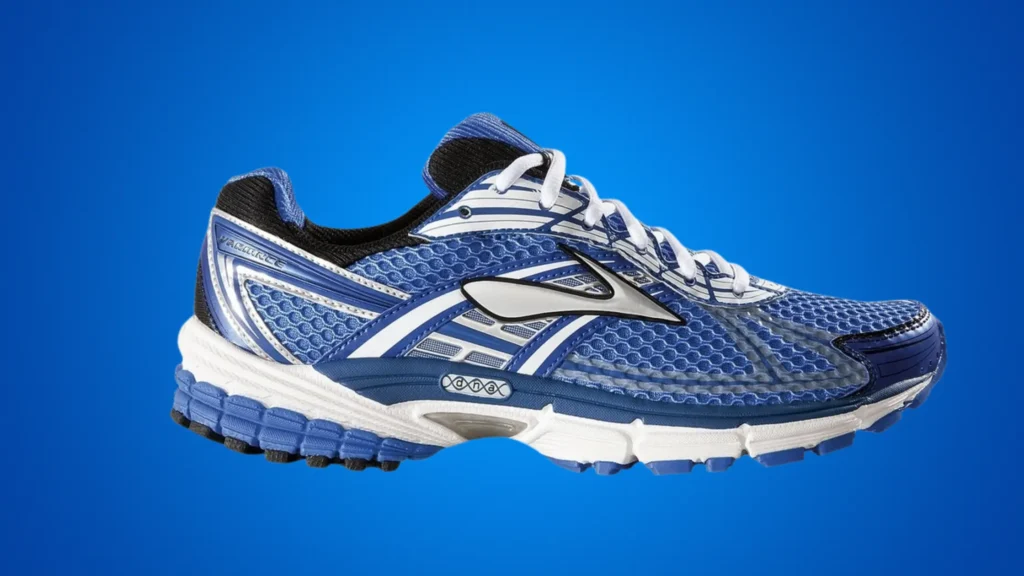
Popular for their midsole cushioning and stability elements, Brooks shoes have great shock absorption, which will not put the sinus tarsi over tension. Several models, including those with orthotic-esque support and structured heel counters, can be perfect for pregnant, wobbly-ankled women in need of increased ankle support.
Hoka One One
Hoka shoes are very cushy and light, which makes them great for standing and walking all day. With their relatively thick midsoles, they absorb the impacts effectively, in effect providing protection to the ankle ligaments involved in sinus tarsi syndrome.
Asics
Asics running and walking shoes feature gel cushioning and firm heel support, which stabilizes the ankle and helps prevent overpronation. Some models are compatible with orthotics, enhancing support for women experiencing pregnancy-related foot changes.
New Balance
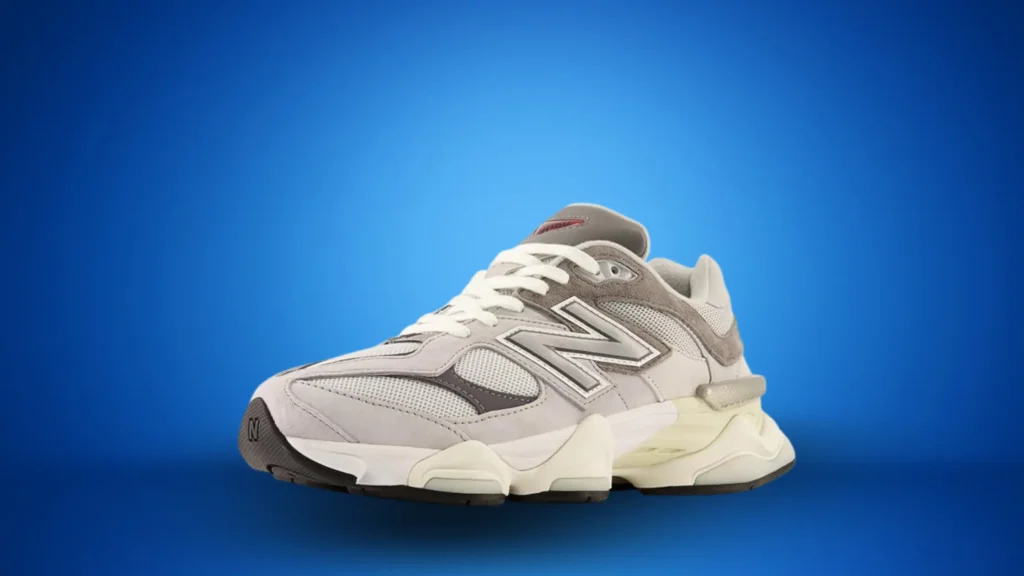
New Balance shoes are ideal for swollen pregnant feet because of their amazing arch support and range of widths. Their arch support encourages more ankle support, which reduces the possibility of aggravating your sinus tarsi syndrome.
Saucony
Saucony specializes in cushioned, stable shoes with springy midsoles. Their footwear cushion and support your feet such that shock is absorbed and proper foot alignment is maintained, all of which results in less strain on the ankles for guys who suffer from sinus tarsi syndrome.
Merrell
Merrell’s hiking and walking footwear features strong support and sturdy outsoles, which will also stabilize the ankle on uneven ground. Their construction minimizes tripping over ankles, which allows for everyday wear as well as the flexibility that comes with pregnancy- a must!
Altra
Altra shoes feature a wide toe box with a zero-drop platform that helps keep the foot in a natural position for added comfort, as well as better impact, stability, and propulsion. This is especially useful when pregnant and the feet are swollen, relieving tension on the sinus tarsi area of the foot.
Orthofeet
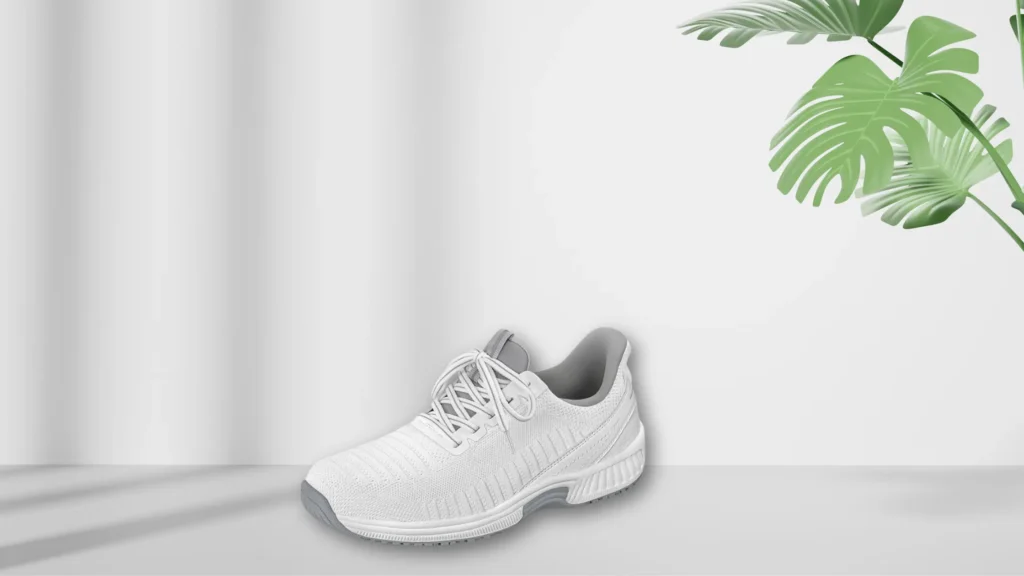
Orthofeet specializes in orthopedic footwear, offering cushioned soles, wide toe boxes, and excellent arch support. Their shoes help reduce pain from sinus tarsi syndrome and accommodate custom orthotics when needed.
Clarks
Clarks shoes combine comfort, stability, and moderate cushioning, making them suitable for pregnant women who need stylish yet supportive everyday footwear. Wide-toe models help prevent pressure on swollen feet and tender ankles.
Vionic
Vionic shoes feature built-in orthotic support and firm heel counters, which help correct overpronation and provide ankle stability. Their cushioned soles reduce stress on the sinus tarsi while maintaining comfort during pregnancy.
FAQs on Sinus Tarsi Syndrome
Q1. What is sinus tarsi syndrome?
It is a painful condition of the small cavity in the ankle that causes instability, swelling, and tenderness, often after sprains or due to foot pronation.
Q2. What are the sinus tarsi syndrome symptoms?
Pain, instability, tenderness in the ankle’s hollow, and difficulty walking on uneven ground are common signs.
Q3. How is sinus tarsi syndrome treated during pregnancy?
Non-invasive methods like supportive shoes, orthotics, gentle exercises, and rest are preferred. Surgery is postponed until after pregnancy.
Q4. What are the best shoes for sinus tarsi syndrome?
Supportive sneakers or orthopedic shoes with cushioning, stability, and room for swelling are ideal.
Q5. What role does radiology play in diagnosis?
MRIs and ultrasounds are the safest and most effective methods for diagnosing sinus tarsi syndrome during pregnancy.
Q6. Can sinus tarsi syndrome exercises help?
Yes. Gentle strengthening and mobility exercises improve stability and reduce pain when performed consistently.
Q7. Is surgery always necessary?
No. Surgery is only considered after conservative treatments fail and is usually delayed until after pregnancy.
Final Thoughts
The sinus tarsi syndrome can greatly disrupt daily life, especially during pregnancy when the body is already under strain. With the right combination of conservative care—like supportive shoes, targeted exercises, and careful medical guidance—most women can manage symptoms safely without surgery.
Addressing this condition early not only reduces pain but also supports better mobility and stability throughout pregnancy and beyond.
Let’s explore more on Pregnancy Must –
